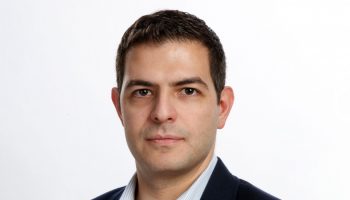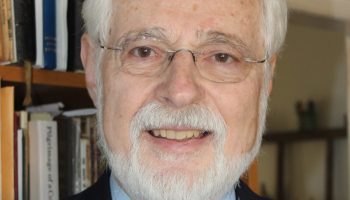It is said the only guarantees in life are taxes and death, but Mirabai Starr argued living through darkness is an additional responsibility humans must bear. Although this darkness can be overwhelming, it can lead to clarifying vision.
Starr, an award-winning author of creative nonfiction and contemporary translations of sacred literature, delivered her lecture, “Dark Nights of Our Souls: The Transformational Power of Spiritual Crisis,” on Tuesday, Aug. 2 in the Hall of Philosophy.
Week Six’s Interfaith Lecture Series theme, “Embracing the Dark: Fertile Soul Time,” refers to a poem by St. John of the Cross, a 16th-century Spanish mystic and priest.
Starr translated the poem, “Dark Night of the Soul,” from its original 16th-century Spanish to modern English. She began her lecture by reading both versions of the text for Chautauquans, inviting them into a “contemplative moment.”
The poem tells a story of a spiritual crisis, using darkness as a metaphor for being unable to find the fiery excitement of life; it describes a deep loss of purpose.
“There is a reason this mystical teaching has survived for 500 years and may be more relevant today than ever,” Starr said. “… If I were to sum up John of the Cross’ teachings on spiritual crisis in one sentence, it would be: When you’re having a spiritual meltdown, melt. Say yes.”
Times of spiritual disconnection are often deeply personal. This inner state of “conceptual emptiness,” Starr said, does not always need a connection to external circumstances.
“Now you’re conditioned to see (the crumbling of your belief system) as a problem, as a broken thing that needs to be fixed,” she said. “… (But) John of the Cross says this is a blessing, and that it’s a sign of spiritual maturity, that your soul has ripened.”
Referring to St. John of the Cross’ use of feminine energy to explain this process, Starr described this crisis as God weaning a baby from her breast to introduce it to delicious bread.
“We throw a (spiritual) tantrum when it all dries up and falls into darkness,” Starr said. “But if we can stay with it, amazing subtle gifts will reveal themselves that wouldn’t if we couldn’t enter into that darkness.”
Admitting she once thought this lesson was deeply private with little connection to external circumstances, Starr learned through her own experiences of grief and utter loss that the internal and external are deeply connected.
On the very day that Starr’s first book came out, a translation of “Dark Night of the Soul,” her 14-year-old daughter, Jenny, was killed in a car accident.
“(This) was the day I was plunged into the deepest, most radical darkness I could have ever imagined,” Starr said. “… So what my own soul recognized when Jenny died and the book came out was that yes, indeed, external circumstances can plunge us into that spiritual crisis.”
Despite the irrefutable presence of darkness that accompanies loss, St. John of the Cross and other mystics recognized this blinding darkness as a form of unutterable light.
“It takes a while of abiding in that darkness before that radiance, that luminosity, can come through, before we can develop those new eyes with which to perceive the light directly,” Starr said.
One of the most difficult aspects of enduring a “Dark Night of the Soul” experience, Starr said, is the inability to welcome the darkness as a blessing, as many fight and dread what is perceived as a great loss.
This is part of the process, however, as no one should try to force a grieving person to see the gift in their loss; the one in grieving must be able to find the light on their own, Starr said.
“But what we can do is accompany each other in the shattering moments and not turn away,” Starr said.
While many feel the urge to run away from a profound loss, Starr advised people to be present with the moment and feel it deeply. She referred to the loss of her daughter, explaining that she felt a maternal instinct to stay present in the loss to honor Jenny as an act of love.
“(There) was this outflowing of love for my daughter,” Starr said. “(I thought) ‘I’m going to stay with this darkness. I am going to be present to this grief because I love you, and I don’t know what else to do, except to say a very soft, very reluctant, yes.’ ”
In spiritual crises, people are often unable to tell they are in one until it is over. A person may be able to pinpoint that they are in the midst of darkness, but Starr said people often can’t know when they are in the midst of a spiritual crisis of high caliber.
Through contemplative practice, though, Starr shared that people can train themselves to be present and relax within the darkness because nothing is truly broken.
“When it’s all empty and dark and dry, it is not a sign of a pathology that needs to be medicated in you,” Starr said. “It’s an invitation to the transformational space of radical unknowing, which is the portal to total intimacy with the sacred.”
St. John of the Cross believed this transformative time to be deeply personal, occurring on an individual basis, but Starr suggested that many, especially in America, are experiencing a collective “Dark Night of the Soul.”
“Our cherished structures are collapsing. Our systems that we relied on to guide us and hold us are coming undone. We are being plunged into darkness,” Starr said. “And as my friend Valarie Kaur asks … ‘Is it the darkness of the tomb or the darkness of the womb?’ ”
Humankind has strived for a system of life rooted in shared values, but through time, many do not dare to believe it is possible to live in a harmonious way, she said.
“But (this new way of life) can only come out of the ashes of the old,” Starr said. “What we need is brave lovers to stand up as a steadying, rooted, hopeful source for others, even if that means midwifing each other through the death that is unfolding globally.”
Many feel the need to retreat from the world’s problems, perceiving that they could not possibly have the power to revive hope. But Starr fights this notion, professing that the “feminine prophetic invitation” awaits a joint force of all people to work in the ashes.

“There is no lone white dude who’s going to come swooping in to save us right now,” she said. “All of us together, people of all genders, and all (identities) — racially, religiously, culturally — it’s only together that we can hope to be instruments of peace in this new emerging reality.”
It seems there is much darkness now, and Starr believes this is not a coincidence.
“What we see on the global horizon is also unfolding in our individual lives, our families, our communities. I don’t think that’s an accident,” Starr said. “It just seems to be a time when we are being weaned, and it hurts.”
Many of the great mystics, whose teachings transcend time, endured darkness in their personal lives. Starr believes their gifts were born from their crises. She created a working list of these figures and their sufferings, sharing snippets of their stories with the audience.
“Teresa of Ávila … had illnesses, near-death experiences, her whole life,” Starr said. “Julian of Norwich had a near-death experience. She wasn’t meant to recover, but she did. … Hildegard of Bingen had terrible debilitating headaches, probably migraines; also the authorities in the church were constantly trying to destroy her.”
After depicting this mosaic of challenging mystic experiences, Starr reminded Chautauquans that their spiritual crises, too, have the power to ennoble them and open a door to the sacred landscape.
Closing the lecture with a poem she wrote to St. John of the Cross, Starr shared her journey of living in the midst of darkness and placing her trust in the Divine.
“I have cultivated my faith with enthusiasm and care, yet it lies withered at my feet. Oh, wise brother and God, remind me that this void is plenitude. This aridity, abundance, this darkness, pure light,” Starr read. “… Give me the strength not to turn away from the pain. … Remind me that only by letting go of all hope can I ever come to receive the fullness of God’s love, a tender filling of every fiber of my broken open soul.”





